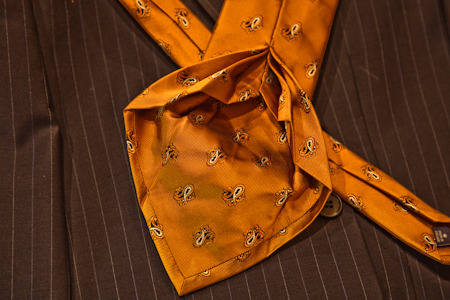
Ian writes:
You recently posted about a $60 tie. My immediate thought when I saw it (and whenever I see any shop that sells what I would term expensive ties) was are they really worth it? What do I get for my money? All my ties are £3 jobs from vintage shops or £9 things off the high street. I even bought a plain black tie for 100 yen when I desperately needed one that I still wear.
The second part of my question is this: am I only failing to see the value of more expensive ties because I find it absurd that a tie can cost more than any shirt I own and about half as much as any suit I own? Would you agree that it is absurd to wear a £60 tie if you only own a £120 suit?
Let’s start with this: is there a difference between a cheap tie and an expensive tie? The answer is an unequivocal “yes.”
The essential component in a tie is a piece of pretty fabric, usually silk. In a cheap tie, this silk is of poor quality – less attractive, prone to damage, lightweight, poorly printed. In the best ties, the silk is richer, thicker and more attractive.
In cheap ties, the manufacturers make every effort to use as little silk as possible. That means wrapping their thin layer of silk around a piece of wool, which provides the heft needed to make a knot. In good ties, this lining is of higher quality, and the secondary silk which covers the backside of the front blade is made of this same silk. In the best ties, the whole tie is made of silk, as pictured above.
The quality of these materials is apparent to the eye, but perhaps the most important quality indicator for a necktie is the quality of the knot. Poor quality neckties tie poorly – their knots lose their dimples, they lack the weight to remain uniform and so on.
Does that mean you should buy expensive neckties? Like any other piece of clothing, that depends on your means and your will.
Certainly I don’t recommend buying most neckties at full price. There are inexpensive neckties – like those from Lands’ End – which will give you solid if unspectacular quality and are often on sale. There are department store brands, like, say, Facconable (usually made by the French maker Breuer) which can similarly be found in the world’s Nordstrom Racks for $30 or so. And of course, if you have the time and a good eye, the necktie is the one item that for the vast majority of men always fits, so it’s the perfect item to buy at thrift and consignment stores.
Of course, there are challenges to this budget approach. The main one is that you’re generally picking through others’ cast-offs. The things at the thrift, the things on sale, they’re always something someone else didn’t want. That means, above all, that you will find lots of oddities and very few basics. This is true of thrift stores and sales and discount stores and the whole nine yards. When you’re dressing with oddities, you will need many more items of clothing than when you’re dressing with basics.
I find though that there are generally two kinds of men. One has many, many neckties. Whether acquired through expensive or inexpensive means, they have more ties than they can reasonably wear. That person would benefit from passing on five or six $10 ties to buy a quality tie in a classic style for $60.
The other is the man with two or three ties. Again, this is a man who for $180 could assure that he would look good, not passable, for the next ten years’ worth of necktie-required events. When you’re spending $1000 to fly to a wedding, perhaps it’s not crazy to spend $60 on a nice tie.